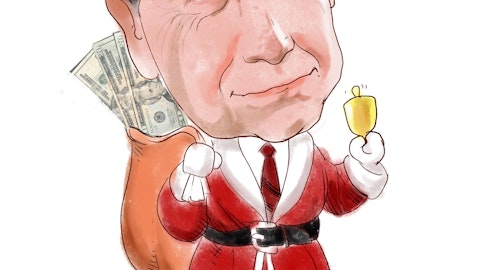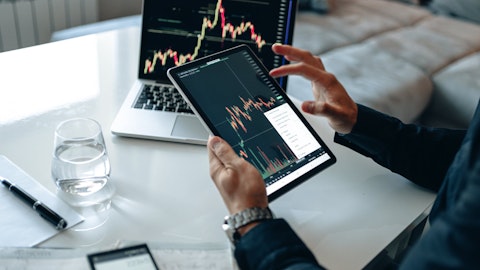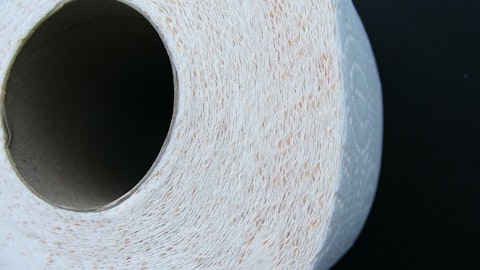H.B. Fuller Company (NYSE:FUL) Q3 2023 Earnings Call Transcript September 28, 2023
Operator: Hello, and thank you for standing by. My name is Regina, and I will be your conference operator today. At this time, I would like to welcome everyone to the H.B. Fuller Third Quarter Earnings Conference Call. All lines have been placed on mute to prevent any background noise. After the speakers’ remarks, there will be a question-and-answer session. [Operator Instructions] I would now like to turn the conference over to Steven Brazones. Please go ahead.
Steven Brazones: Thank you, operator. Welcome to H.B. Fuller’s third quarter 2023 investor conference call. Presenting today are Celeste Mastin, President and Chief Executive Officer; and John Corkrean, Executive Vice President and Chief Financial Officer. After our prepared remarks, we will have a question-and-answer session. Before we begin, let me remind everyone that our comments today will include references to certain non-GAAP financial measures. These measures are supplemental to the results determined in accordance with GAAP. We believe that these measures are useful to investors in understanding our operating performance and to compare our performance with other companies. Reconciliation of non-GAAP measures to the nearest GAAP measure are included in our earnings release.

Copyright: chamillewhite / 123RF Stock Photo
Unless otherwise noted comments about revenue refer to organic revenue and comments about EPS, EBITDA and profit margins refer to adjusted non-GAAP measures. We will also be making forward-looking statements during this call. These statements are based on current expectations and assumptions that are subject to risks and uncertainties. Actual results could differ materially from these expectations due to factors covered in our earnings release, comments made during this call, and the risk factors detailed in our filings with the Securities and Exchange Commission, all of which are available on our website at investors.hbfuller.com. I will now turn the call over to Celeste Mastin. Celeste?
Celeste Mastin: Thank you, Steven, and welcome everyone. In the third quarter, we delivered a double-digit increase in adjusted EBITDA year-on-year and successfully drove adjusted EBITDA margin meaningfully higher. We achieved this despite weaker-than-expected volumes, driven by a more adverse customer destocking impact in Hygiene, Health, and Consumable Adhesives, and lower market demand in construction-related markets. Customer destocking actions have been temporarily detrimental to organic growth leading to volume declines in excess of underlying economic demand. While challenging in the short-term we are successfully managing through this highly unusual phenomenon taking actions that reduce our cost structure, while sustainably executing our price-to-value discipline, and leveraging our raw material scale.
I am quite pleased that we were able to achieve double-digit growth in adjusted EBITDA in the current environment and without question the actions we are taking will continue to benefit our ability to grow adjusted EBITDA in 2024, and well into the future. Overall organic revenue declined 7.4% year-on-year in the third quarter with all GBUs experiencing lower volume versus the prior year. Overall, the sequential trend in volume largely followed the path we expected with the exception being the magnitude of volume impact in HHC. Customer destocking actions in EA and CA are largely complete and we believe they have peaked for HHC in the third quarter. Incremental volume development has been improving since the second quarter trough and we expect this to continue and meaningfully improve in the fourth quarter.
From a profitability perspective, we overcame short-term volume challenges to achieve a 13% increase in adjusted EBITDA year-on-year and increased adjusted EBITDA margin 270 basis points year-over-year and 140 basis points sequentially from Q2 to 17.3%. The benefits from sustainable pricing discipline, proactive raw material cost management, and restructuring savings realization more than offset the detrimental impact from lower volume and drove the improvement in profitability in the third quarter. We also delivered another outstanding quarter from a cash flow perspective with cash flow from operations increasing $50 million year-on-year to $108 million, driven by strong profit growth and improved working capital performance. Now let me move on to review the performance in each of our segments in the third quarter.
In HHC, organic revenue was down 10.5% year-on-year driven by HHC’s customer destocking activity, which we estimate accounted for most of the decline in organic growth. Since the pandemic, most of HHC’s customers held significantly higher inventories of raw materials to mitigate the risk of supply chain availability. This has created a very unique situation for channel inventory destocking in 2023 that is unprecedented historically and has led to volume declines for HHC that have never been experienced before. With that said, we know this to be temporary as underlying demand is stronger than our volume reflects, and we’ve also recently seen distributor buying patterns improve. Although underlying demand is down slightly given the current economic environment, we are encouraged by the trends in HHC.
The team has been successful in gaining new business. This will become much more evident once the HHC customer destocking actions conclude. Adjusted EBITDA for HHC increased 12% year-on-year to $69 million, and adjusted EBITDA margin increased 270 basis points to 17.2%. This is quite impressive given the significant short-term volume challenges we have endured. Favorable price and raw material cost management and restructuring benefits drove the improvement year-on-year. In Engineering Adhesives, organic revenue declined 3.3% in the third quarter much improved versus the 9% decline in the previous quarter led by strength in China. Organic revenue declined due primarily to lower volume in construction-related end markets, which more than offset organic growth in the automotive, electronics, and solar market segments.
Adjusted EBITDA in EA increased 26% year-on-year and adjusted EBITDA margin increased 450 basis points year-on-year to 19.3%. The improvement in profitability for EA was driven by favorable price and raw material actions and aggressive cost management. In Construction Adhesives, organic revenue declined 9.4% year-on-year, a marked improvement versus organic revenue declines of 26% in Q1 and 14% in Q2. Customer destocking impacts in CA continued to taper in the third quarter as expected and are largely complete now. However, end-market demand has weakened in construction-related end markets, and we would ascribe most of the organic revenue declines in the third quarter to end-market conditions. Adjusted EBITDA for CA was down modestly year-on-year and adjusted EBITDA margin of 14% was effectively flat as favorable price and raw material cost actions as well as restructuring benefits offset the impact of lower volume.
The restructuring actions the CA team has executed position this business to deliver sustainably strong adjusted EBITDA margins consistently throughout the cycle. Geographically, Americas organic revenue was down 13% year-on-year. Customer destocking impacts in HHC which were notably outsized in North America relative to the rest of the world, adversely impacted the region’s organic revenue development in the third quarter. In EIMEA, organic revenue declined 6% year-on-year, driven mostly by weaker demand in the construction and packaging-related market segments. In Asia-Pacific, organic revenue increased 7% year-on-year, driven by a rebound in demand in China in both EA and HHC. The organic sales trend for the region continued to improve as expected due to particular strength in the automotive, electronics, and hygiene market segments.
From a global economic standpoint, conditions remain relatively weak. Accordingly, we have executed supplemental restructuring initiatives, which will increase our expected annualized pre-tax savings by approximately $10 million once fully implemented. On the M&A front, we recently acquired Sanglier Limited one of Europe’s largest independently owned manufacturers and fillers of sprayable industrial adhesives. This complementary acquisition expands our innovation capabilities and product portfolio across the U.K. and Europe, particularly in the Construction Adhesives and Engineering Adhesives businesses. In addition, during the third quarter, we announced the restructuring of the recently acquired Beardow Adams business once completed this restructuring is expected to result in an ongoing annualized cost savings of approximately $20 million on a pre-tax basis.
This is an addition to the restructuring initiative we announced in the first quarter. The majority of the restructuring charges and run rate cost savings associated with this restructuring are expected to be recognized in fiscal year 2024. The Beardow Adams restructuring benefit represents a significant portion of the fiscal 2025 EBITDA contribution from the 2023 collection of acquisitions, which we now expect to contribute approximately $60 million of incremental EBITDA by 2025. Lastly, I would like to inform you that the recent acquisition of Adhezion Biomedical is progressing exceptionally well and is on track for a record sales year. We have a well-defined plan for synergy realization and we are very excited about the future growth prospects of our medical adhesives business.
Now let me turn the call over to John Corkrean to review our third quarter results in more detail and our outlook for 2023.
John Corkrean: Thank you, Celeste. I’ll begin on slide seven with some additional financial details on the third quarter. For the quarter, revenue was down 4.3% versus the same period last year. Currency had a negative impact of 1.7%, and acquisitions positively impacted net revenue by 4.8%. Adjusting for those items organic revenue was down 7.4% with pricing having a favorable impact of 0.6% year-on-year in the quarter, and volume had a detrimental impact of 8% reflecting customer destocking impacts, particularly in HHC and a general slowdown in industrial demand. Adjusted gross profit margin was 30%, up 350 basis points versus last year as a net effect of pricing and raw material cost actions together with restructuring benefits, and general cost controls more than offset the impact of lower volume.
Adjusted selling, general and administrative expense was up slightly year-over-year. Good cost management, growing restructuring benefits, lower variable compensation and favorable foreign currency impacts largely offset the incremental SG&A from acquisitions and inflation in wages and other costs. Adjusted EBITDA for the quarter of $156 million was up 13% year-on-year, and adjusted EBITDA margin increased to 17.3%, up 270 basis points compared to the third quarter of last year. This reflects proactive actions taken to optimize the price and raw material dynamics, as well as restructuring benefits and other cost savings measures. These actions combined with the contribution from accretive acquisitions more than offset lower volume, unfavorable foreign exchange, and wage and other inflation during the quarter.
Adjusted earnings per share of $1.06 was flat versus the third quarter of 2022, as strong operating income growth was offset by significantly higher interest expense and unfavorable foreign currency. Higher interest expense and unfavorable foreign exchange negatively impacted adjusted EPS in the third quarter by approximately $0.17 and $0.05 respectively. Operating cash flow in the quarter improved significantly year-over-year as improving margins and lower net working capital requirements more than offset the impacts of lower volume, higher interest expense and unfavorable foreign currency translation. Third quarter and year-to-date cash flow from operations increased year-over-year by $50 million and $168 million respectively. With that, let me now turn to our guidance for the 2023 fiscal year.
We now expect full-year net revenue for fiscal 2023 to be in the range of $3.5 billion to $3.55 billion, and taking into consideration the extra week in 2022, we now expect organic revenue to be down 4.5% to 5.5% versus fiscal 2022. This reflects lower than previously expected volume, due to a more significant destocking impact in HHC in Q3, and slightly weaker overall industrial demand conditions. Additionally, we now expect adjusted EBITDA to be $580 million to $590 million representing a 9% to 11% year-on-year increase. This reflects lower organic revenue expectations, offset by a more favorable pricing and raw material dynamic, additional cost reductions as well as the benefit of value-creating acquisitions completed this year. Furthermore, we now expect net interest expense to be approximately $135 million for the fiscal year, and the full-year adjusted effective tax rate to be between 27% and 28%.
Combined these assumptions result in full year adjusted earnings per share in the range of $3.80 to $3.90. Also, we now expect full year capital expenditures to be approximately $125 million. Regarding savings from restructuring plans, we now expect actions from the previously announced and subsequently expanded strategic restructuring to generate between $40 million and $45 million in annual pre-tax run-rate cost savings, up from our original estimate of $30 million to $35 million. This is an addition to approximately $20 million of pre-tax run rate savings associated with the Beardow Adams integration which was announced during the third quarter. Now let me turn the call back over to Celeste to wrap us up.
Celeste Mastin: Thank you, John. Strategically, we are driving this business where we said we would, as evidenced by our gross profit and EBITDA margin performance demonstrating our confidence, and becoming a higher EBITDA margin company. We strive to be recognized as the imperative ingredient to our customers’ success. We are committed to driving innovative solutions for our customers to create valuable, and sustainable solutions using drops, not trucks of adhesives. I would like to thank all of our H.B. Fuller team members around the world for delivering exceptional results in a challenging environment, and for leading the way as we transform our company into a higher growth, higher margin, higher ROIC business. That concludes our prepared remarks for today. Operator, please open the line for questions.
See also 17 Biggest Mistakes New Business Owners Make and 12 Best Places to Retire in Dominican Republic.
Q&A Session
Follow Fuller H B Co (NYSE:FUL)
Follow Fuller H B Co (NYSE:FUL)
Operator: [Operator Instructions] Our first question will come from the line of Jeffrey Zekauskas with JPMorgan. Please go ahead. Jeffrey, you may be on mute. Our next question will come from the line of Patrick Cunningham with Citi. Please go ahead.
Patrick Cunningham: Hi, good morning.
Celeste Mastin: Good morning, Patrick. How are you?
Patrick Cunningham: Good. How are you?
Celeste Mastin: Good.
Patrick Cunningham: On the strategic M&A update, you know, you cited this $60 million figure up from the previous $50 million. Can you quantify how much of that is coming from the latest acquisition versus maybe there is better than expected in adhesion or other incremental synergies?
Celeste Mastin: Yes, it is a blend of both the impact of Sanglier, as well as better performance across the collection. We prefer not to quantify — we prefer not to quantify how much, you know each particular acquisition brings to the blend, but it is composed of both.
Patrick Cunningham: Yeah. That makes sense. And then just you had the comment that you’re encouraged by trends in HHC, and just underlying demand as well as share gains there. So, what end markets have the best underlying demand? And where are you gaining share? And where do you think any particular end markets, you’ll see a restock in 2024?
Celeste Mastin: And when you say end markets, just for clarity are you talking about the segments within HHC, or are you talking more so about the different GBUs?
Patrick Cunningham: You know either of both, but typically, particularly within HHC.
Celeste Mastin: Okay, great. So within HHC, we are not in any of these businesses, I should just clarify. We are not planning for big restocking impacts. What we expect is we will progress through the destocking in HHC over the next two or three quarters and then we’ll revert to, sort of, more normal demand that may be a couple of percent lower than what we normally would see in any given year. And we are experiencing some great wins with big consumer product companies, which are part of that space. We have seen a number of wins lately in the Hygiene space for example. And so we are going to — you’ll see strong performance there as well as taking share in a number of packaging applications in HHC. So HHC, you know, I have really a favorable outlook for that particular business.
Again, we have got to work through the destocking. Now we are also experiencing some great wins in our other business units as well. In EA, for example, we just had a big win in fuselage airline sealants. So in the aerospace industry, as well as we continue to expand our position in the EV automotive market, a market that’s growing very, very fast globally about 22% annually, and some nice wins in Technical Textiles, Harting Cables, PVC Edge Banding. So really we have a very fragmented space with these 30 different global market segments, and we’re driving wins in all of them, particularly EA, and also seeing some big wins in HHC.
Patrick Cunningham: Very helpful. Thank you. I’ll pass it on.
Operator: Your next question comes from the line of Ghansham Panjabi with Baird. Please go ahead.
Ghansham Panjabi: Hey guys. Hood morning. Hopefully, you can hear me okay?
Celeste Mastin: Good morning, Ghansham.
Ghansham Panjabi: Good morning, Celeste. You know, I guess in context of the 8% volume decline in 3Q. Can you sort of take us through the cadence throughout the quarter and what you’re seeing thus far in September? And also EBITDA margins were up, I think 270 basis points year-over-year during the third quarter. Are you forecasting additional year-over-year margin expansion in 4Q? We are just trying to reconcile your guidance for the quarter.
Celeste Mastin: Right. Okay. So let’s talk about the quarter and your question on volume declined month-over-month. So RP7 which was the first month of our quarter was much worse than the other two. So in P7, we saw really extreme destocking in our HHC business, but also our EA and CA businesses were down double-digit on volume in that month as well. We saw real inflection point for the EA business in particular come P8, and really experienced more flat volumes in EA, P8 and P9 and a lot of that was due to this rebound in China. So, we are seeing strong performance in China. In fact, when you look at China from Q1 to Q3, our volume has swung from a negative 15% roughly to a positive. So, I give the team in China a lot of credit to be nimble enough to handle operationally that shift in volume.
And also we saw in the CA business also sort of some leveling off in the back end of the quarter. Your question around P10 really much, much more of the same. So we are really seeing HHC starting to settle out a little bit, but there’s still destocking there. That’s going to go on for a couple of quarters, however in EA and CA, I think this destocking is completed, and we are seeing much, much better volumes in P10 for both of those businesses.
John Corkrean: Maybe I can comment on the — your question on margins, Ghansham. So, we are forecasting additional margin expansion in Q4. If you look at our guidance range, both for revenue and EBITDA that’s what is reflected and we are seeing that so far in P10. We are seeing margins continue to expand. We would expect a bigger contribution from restructuring in Q4 than we’ve had the previous quarter. So something on the order of 100 basis points of margin expansion in the fourth quarter is more or less in line with our forecast.




